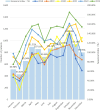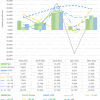To study the impact of COVID-19 on the epidemiological characteristics of allergic rhinitis based on local big data in China
- PMID: 39443644
- PMCID: PMC11500020
- DOI: 10.1038/s41598-024-76252-w
To study the impact of COVID-19 on the epidemiological characteristics of allergic rhinitis based on local big data in China
Abstract
To investigate the big data characteristics and trend changes of patients with allergic rhinitis (AR) who sought medical attention at our hospital before (from 2018 to 2019) and after (from 2020 to 2023) COVID-19, and provide reference basis for the treatment of AR. This study used a descriptive epidemiological method to analyze the big data and trend changes of AR patients. A total of 62,196 AR patients were collected, of whom 32,874 were male and 29,322 were female, with an age range of 1-89 years. The monthly change trend of AR patients showed a marked seasonality. The number of AR patients increased year by year. There was no significant difference in the number of patients between different genders. There was a significant difference in the number of patients between different age groups. The number of AR patients increased markedly from 2018 to 2023, and COVID-19 seems to have accelerated this process. There is a clear seasonal pattern. The number of boy patients is significantly higher than that of girl patients, and the change in female hormones may affect the incidence of AR. Therefore, it is necessary to update management measures and formulate relevant policies in response to the changing trend of AR since the COVID-19 epidemic.
Keywords: Allergic rhinitis; Big data; COVID-19; Epidemiological studies; Prevalence.
© 2024. The Author(s).
Conflict of interest statement
The authors declare no competing interests.
Figures
Similar articles
-
The Association between Ambient Air Pollution and Allergic Rhinitis: Further Epidemiological Evidence from Changchun, Northeastern China.Int J Environ Res Public Health. 2017 Feb 23;14(3):226. doi: 10.3390/ijerph14030226. Int J Environ Res Public Health. 2017. PMID: 28241509 Free PMC article.
-
[Analysis of big data characteristics of allergic rhinitis patients in Beijing City from 2016 to 2021].Zhonghua Yu Fang Yi Xue Za Zhi. 2023 Sep 6;57(9):1380-1384. doi: 10.3760/cma.j.cn112150-20220928-00936. Zhonghua Yu Fang Yi Xue Za Zhi. 2023. PMID: 37743298 Chinese.
-
Online public attention toward allergic rhinitis in Wuhan, China: Infodemiology study using Baidu index and meteorological data.Front Public Health. 2022 Oct 3;10:971525. doi: 10.3389/fpubh.2022.971525. eCollection 2022. Front Public Health. 2022. PMID: 36262246 Free PMC article.
-
Allergic rhinitis and COVID-19: friends or foes?Eur Ann Allergy Clin Immunol. 2022 Mar;54(2):53-59. doi: 10.23822/EurAnnACI.1764-1489.234. Epub 2021 Sep 10. Eur Ann Allergy Clin Immunol. 2022. PMID: 34503647 Review.
-
Advances and highlights in allergic rhinitis.Allergy. 2021 Nov;76(11):3383-3389. doi: 10.1111/all.15044. Epub 2021 Aug 17. Allergy. 2021. PMID: 34379805 Review.
References
-
- Dierick, B. J. H. et al. Burden and socioeconomics of asthma, allergic rhinitis, atopic dermatitis and food allergy. Expert Rev. Pharmacoecon Outcomes Res.20, 437–453. 10.1080/14737167.2020.1819793 (2020). - PubMed
MeSH terms
Grants and funding
LinkOut - more resources
Full Text Sources
Medical
Research Materials



